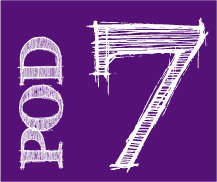Final Project Creation
 In this pod, students will learn how to take the notes and information they’ve learned and organized and put it all together in a presentation. They will learn to consider audience and presentation style as a means of expressing their ideas. Students will also be introduced to a number of Web 2.0 presentation tools, giving them and you a break from the more traditional slide shows and posters. Download Pod.
In this pod, students will learn how to take the notes and information they’ve learned and organized and put it all together in a presentation. They will learn to consider audience and presentation style as a means of expressing their ideas. Students will also be introduced to a number of Web 2.0 presentation tools, giving them and you a break from the more traditional slide shows and posters. Download Pod.
Topics in this Pod
- Computer time: final research and creating final projects
- Practice presenting
Essential Questions
- What information should I share with the audience?
- Who is my audience?
- What do I want my audience to know about my topic?
- Why am I presenting?
- How should I show my information?
- How should I tell my information?
Vocabulary
- Audience: the group of people viewing or listening to a presentation, play, movie, concert, etc.
- Tone: the type of words or way of speaking; changes depending on setting and audience
- Visual aid: a digital or analog accompaniment to a presentation designed to help express ideas and draw out the main ideas for the audience
Activities
Modeling Project Organization. During this activity, students will learn about how an audience influences the way a presentation is created and given. See More.
Creating a Project Plan. During this activity, learners will create a short list of what they want their audience to get out of their presentation and the images they most want to share. Simultaneously, the librarian will demonstrate different Web 2.0 tools. In small groups, students can choose which tools they would like to see demonstrated. See More.
Building Your Presentation. During this activity, students will complete their final project. See More.
Goals
At the end of the pod, students will be able to:
- Organize information that they have found in a manner where it can be used to develop a presentation;
- Synthesize information that they have found in a manner that will best demonstrate the main ideas of their research;
- Decide on a presentation format that best delivers their content; and
- Outline and create their presentation.
AASL Standards
2.1.4 Use technology and other information tools to analyze and organize information.
2.1.6 Use the writing process, media and visual literacy, and technology skills to create products that express new understandings.
3.1.4 Use technology and other information tools to organize and display knowledge and understanding in ways that others can view, use, and assess.
4.1.7 Use social networks and information tools to gather and share information.
4.1.8 Use creative and artistic formats to express personal learning.
Modeling Project Organization.
- Considering the research question the whole group has been working on (e.g. Alzheimer’s), discuss what would be the best way to show and tell the information to a group of 6th-8th graders. Throughout the activity, record answers on chart paper to refer back to if needed.
- Then ask students how their answers would be different if they were presenting to a different audience (parents, patients, etc).
Creating a Project Plan.
Project Planning
- Have students create a short list (3-5 items) of what they want their audience to get out of their presentation.
- Then, have them write down ideas of 3-5 images to search for that they would most want to share about their topic.
- Use a notecard for these lists so that students can review before they begin to create their presentation and before they present.
Web 2.0 Demonstration
- Share a list of Web 2.0 Tools with all students. Use our handout of useful tools or create your own. Tell students which tools you will be demonstrating during the planning session.
- Demonstrate these tools in short sessions. Allow students to pick and choose which sessions they want to see while the whole group continues to work on their project plans.
- At the end of the session, have learners choose the tool they actually want to use for their presentation.
Building Your Presentation.
- Have students create their presentation.
- Remind students to consider their audience and assist with the preparation of the final project.
